NCERT Solutions for Class 9 Maths Chapter 5 Exercise 5.1 - Introduction To Euclid's Geometry
The exercise establishes the fundamental basis of Euclidean geometry through its presentation. This turns toward knowing Euclid's method of constructing logical geometry with his definitions and axioms and postulates. The programmed approach created fundamentals to produce advanced geometrical theorems and constructions by tracing facts down from essential starting points thus establishing the core structure of classical geometry.
This Story also Contains
- NCERT Solutions Class 9 Maths Chapter 5: Exercise 5.1
- Topics Covered in Chapter 5 – Introduction to Euclid’s Geometry (Exercise 5.1)
- NCERT Solutions of Class 10 Subject Wise
- Subject-Wise NCERT Exemplar Solutions
Through this exercise students learn to differentiate between axioms and postulates by analyzing their importance as well as their application process for creating mathematical logic systems. Students can better comprehend complex abstract geometrical concepts through these guided NCERT Solutions which function perfectly with regular NCERT Books for constructing a firm foundation in geometry.
NCERT Solutions Class 9 Maths Chapter 5: Exercise 5.1
Q1 Which of the following statements are true and which are false? Give reasons for your answers.
(i) Only one line can pass through a single point.
(ii) There are an infinite number of lines which pass through two distinct points.
(iii) A terminated line can be produced indefinitely on both the sides.
(iv) If two circles are equal, then their radii are equal.
(v) In Fig. 5.9, if AB = PQ and PQ = XY, then AB = XY.
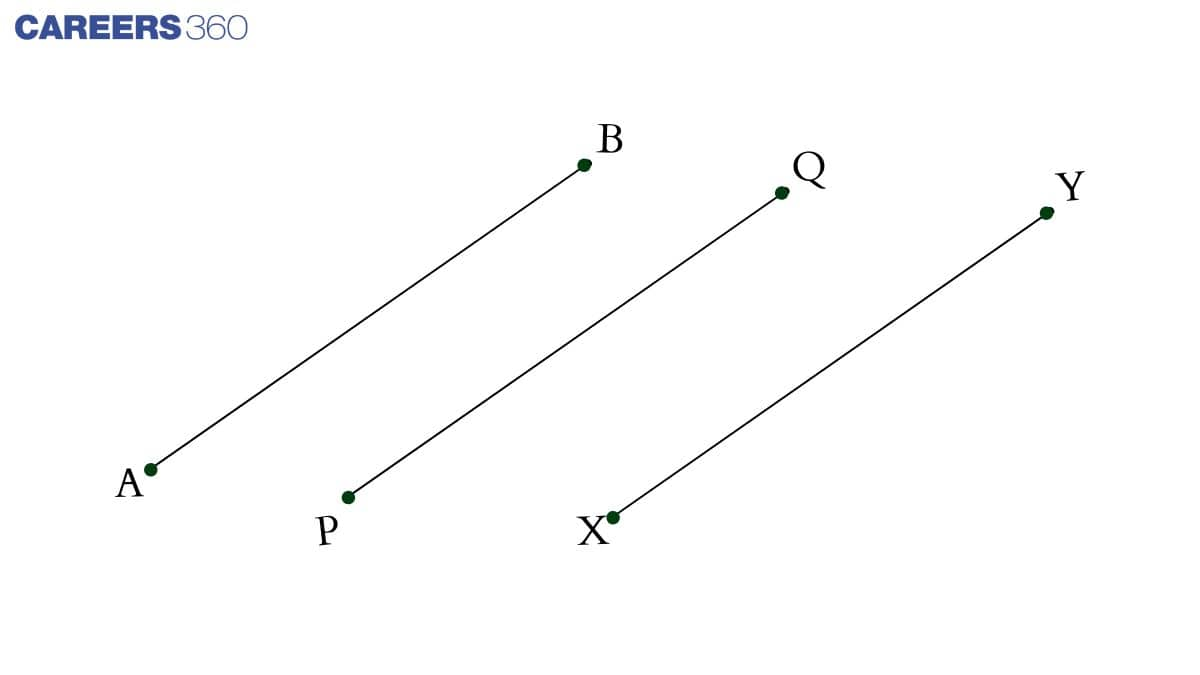
Answer:
i) FALSE
Because, the single point allows an infinite number of parallel lines to be drawn through it. As shown in the diagram below
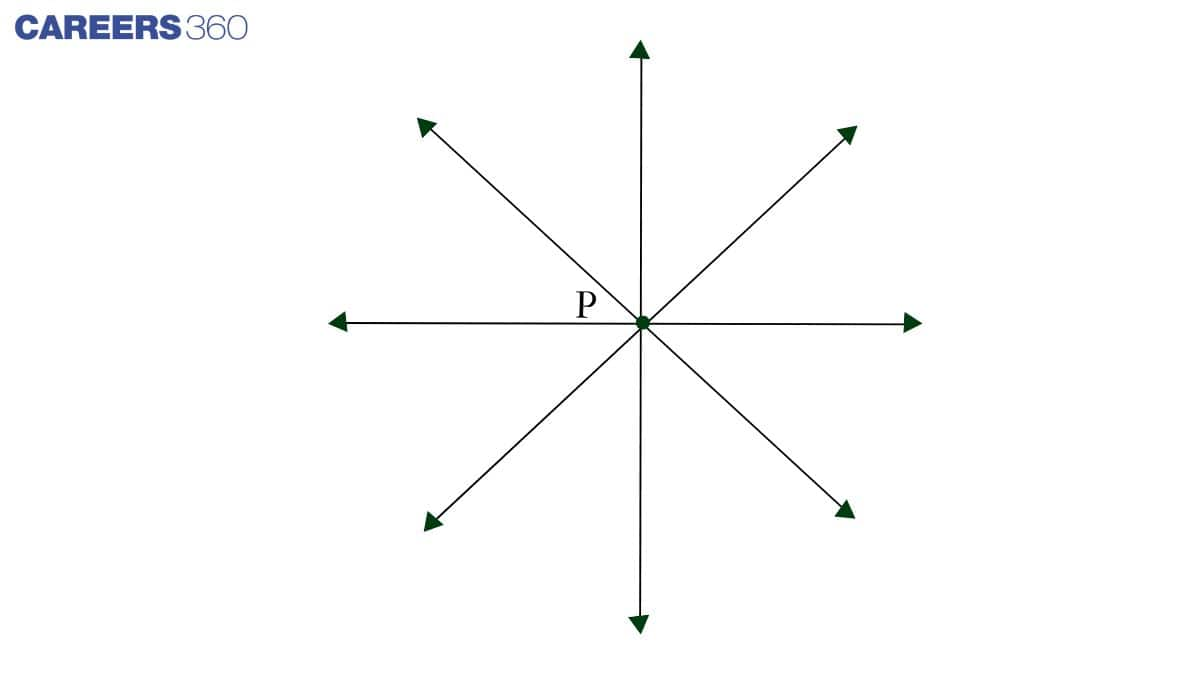
ii) FALSE
Because, one line exists between two distinct points because of fundamental mathematical principles. As shown in the diagram below
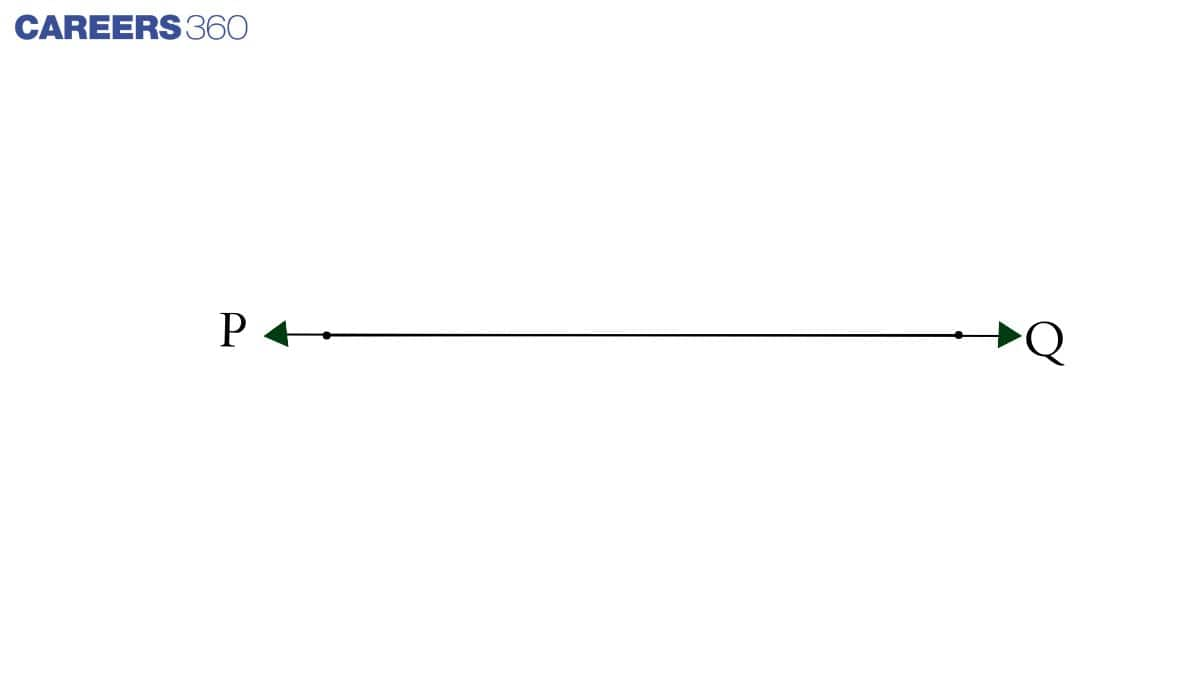
iii) TRUE
Because, the production of a terminated line remains possible without limits from both sides. As shown in the diagram below
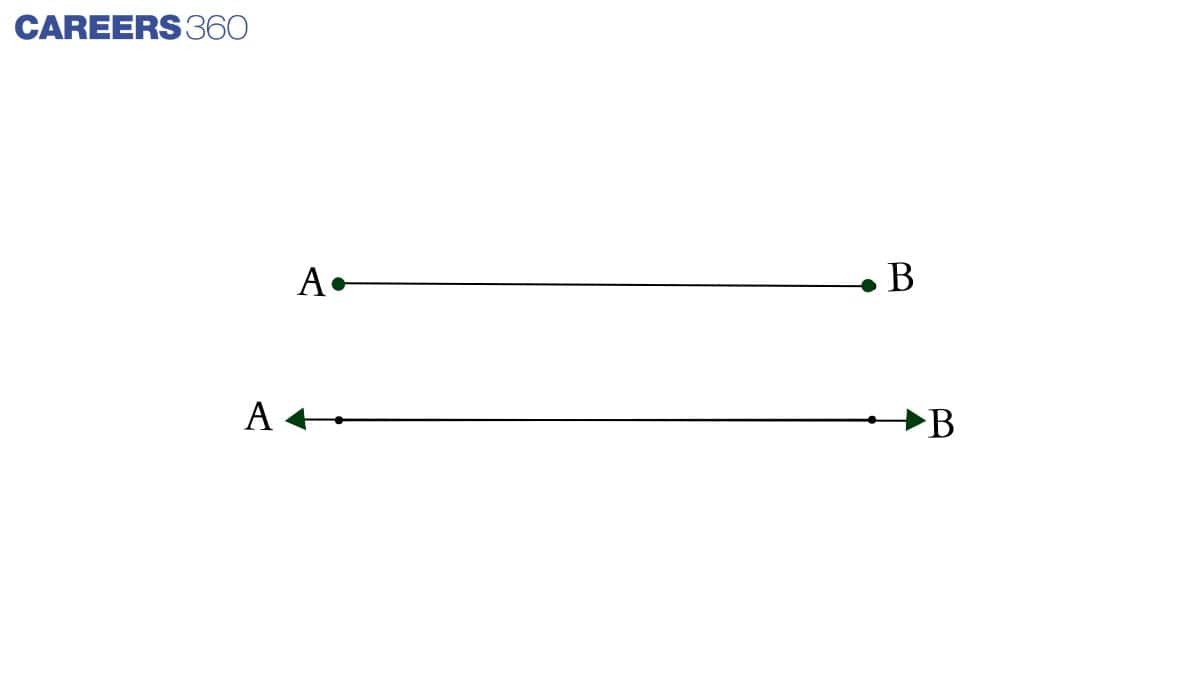
iv) TRUE
Because, when two circles match in size then both their central points together with their outer boundaries align perfectly while their radii become equal with each other.
v) TRUE
By Euclid’s first axiom things which are equal to the same thing, are equal to one another.
Answer:
Yes, there are other terms that are needed to be defined first which are:
Plane: An infinite flat two-dimensional surface defines what a plane represents
Point: Points represent small dots which hold no dimensions like length, breadth or height and exist only to indicate position.
Line: The definition of a line describes an infinite straight one-dimensional shape without thickness which continues indefinitely forward and backward.
i) Parallel line:-
if two lines in a plane never cross one another and their perpendicular distance is always constant. Two lines are thus referred to as parallel lines.
Answer:
Yes, there are other terms that are needed to be defined first which are:
Plane: An infinite flat two-dimensional surface defines what a plane represents
Point: Points represent small dots which hold no dimensions like length, breadth or height and exist only to indicate position.
Line: The definition of a line describes an infinite straight one-dimensional shape without thickness which continues indefinitely forward and backward.
ii) perpendicular line:-
If two lines intersect with each other and make a right angle at the point of intersection. Then, two lines are called perpendicular lines.
Answer:
Yes, there are other terms that are needed to be defined first which are:
Plane: An infinite flat two-dimensional surface defines what a plane represents
Point: Points represent small dots which hold no dimensions like length, breadth or height and exist only to indicate position.
Line: The definition of a line describes an infinite straight one-dimensional shape without thickness which continues indefinitely forward and backward.
iii) line segment:-
A line segment is a straight line having two end points that have a fixed length and cannot be stretched further.
Answer:
Yes, there are other terms that are needed to be defined first which are:
Plane: An infinite flat two-dimensional surface defines what a plane represents
Point: Points represent small dots which hold no dimensions like length, breadth or height and exist only to indicate position.
Line: The definition of a line describes an infinite straight one-dimensional shape without thickness which continues indefinitely forward and backward.
iv) Radius of the circle: -
The radius of a circle is the separation between the circle's center and any point on its circumference.
Q2 (v) Give a definition for each of the following terms. Are there other terms that need to be defined first? What are they, and how might you define them? v) square
Answer:
Yes, there are other terms that are needed to be defined first which are:
Plane: An infinite flat two-dimensional surface defines what a plane represents
Point: Points represent small dots which hold no dimensions like length, breadth or height and exist only to indicate position.
Line: The definition of a line describes an infinite straight one-dimensional shape without thickness which continues indefinitely forward and backward.
v) Square:-
Any quadrilateral with equal four sides and right angles at all interior angles is called a square.
Q3 Consider two ‘postulates’ given below:
(i) Given any two distinct points A and B, there exists a third point C which is in between A and B.
(ii) There exist at least three points that are not on the same line.
Do these postulates contain any undefined terms? Are these postulates consistent?
Do they follow from Euclid’s postulates? Explain.
Answer:
The following postulates contain a number of undefined terms:
1) No information regarding the plane is provided, including whether or not the points are in the same plane.
2) A plane has an endless number of points. However, it is unclear from this point C's location whether it is on the line segment that joins AB or not.
Yes, these postulates hold true and consistent in the following two scenarios:
(i) Point C is located on the line segment that connects A and B.
(ii) The line segment connecting A and B does not contain Point C.
No, Euclid's postulates don't support them. They adhere to the principles.
Answer:
Given, AC = BC
Now, draw the figure as below:
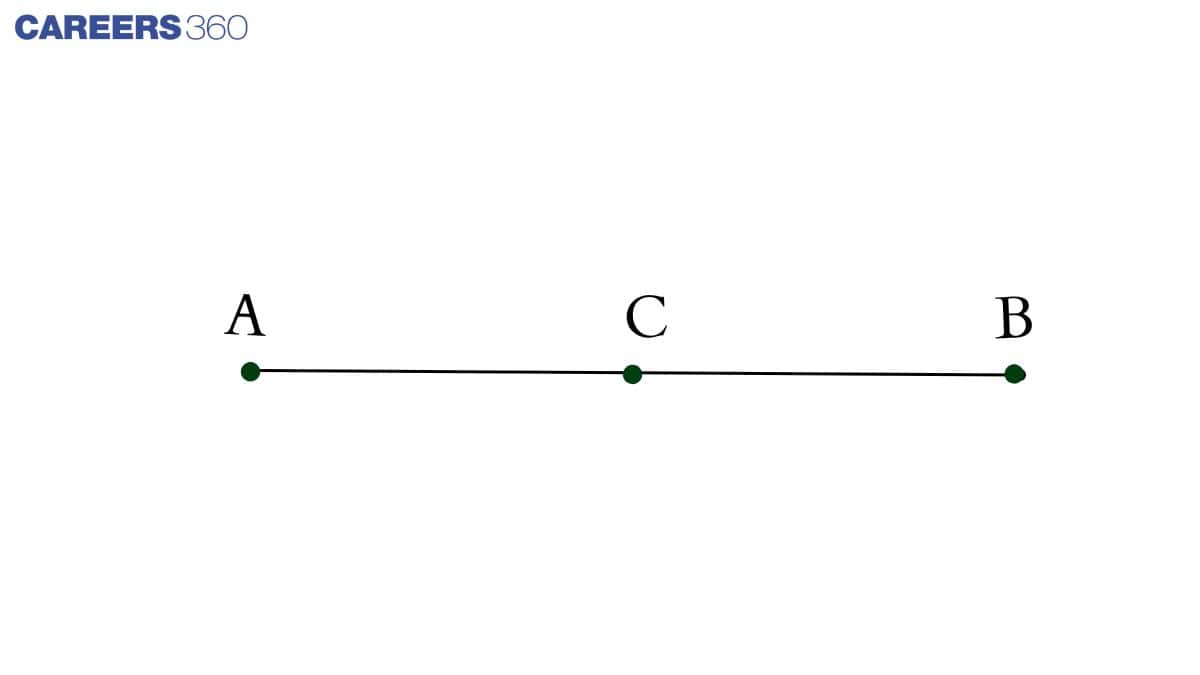
In the figure, AB coincides with AC + BC.
Also, Euclid’s Axiom (4) says that things which coincide with one another are equal to one another. Hence, it is deduced that AC + BC = AB
So from this we can conclude; 2AC = AB $(\because AC = BC )$
Therefore, $AC = \frac{1}{2}AB$
Hence proved.
Answer:
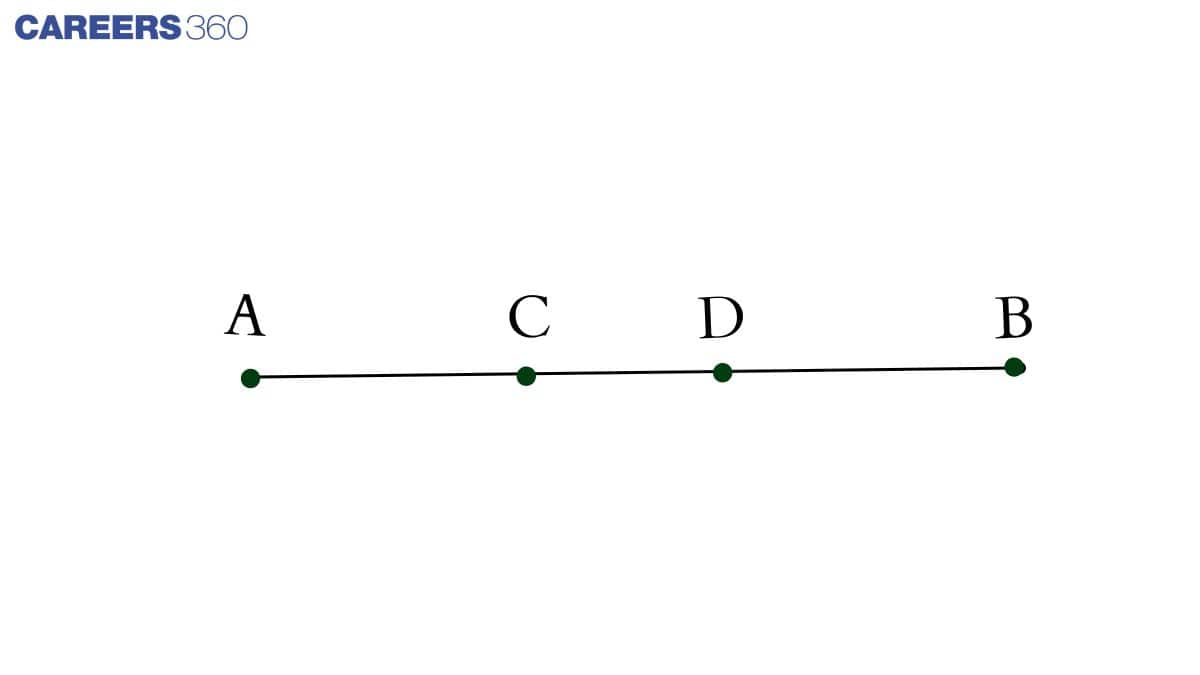
Let's consider, there are two midpoints C and D of a line segment A and B.
Now, If C is the midpoint then, AC = BC
And, this concludes, AB coincides with AC + BC.
Also, Euclid’s Axiom (4) says that things which coincide with one another are equal to one another. So, it can be deduced that AC + BC = AB
Therefore, we can say that
2AC = AB -(i)
Similarly, in case of point D.
If D is the midpoint then, AD = BD
And, when considering the figure we can conclude, AB coincides with AD + BD.
Also, Euclid’s Axiom (4) says that things which coincide with one another are equal to one another. So, it can be deduced that AD + BD = AB
From this, we can say that
2AD = AB -(ii)
Now,
From equation (i) and (ii) we get
AD = AC
and this is only possible when C and D are the same points
Hence, our assumption is wrong and there is only one midpoint of line segment AB.
Q6 In Fig. 5.10, if AC = BD, then prove that AB = CD.
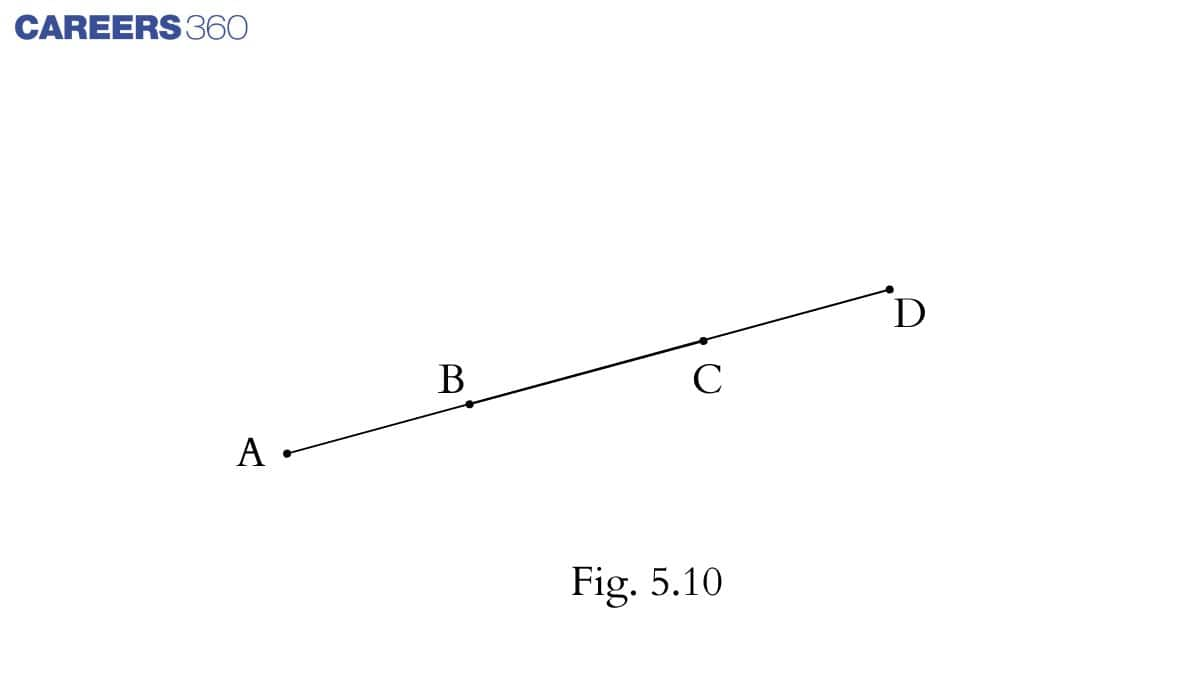
Answer:
From the figure given,
We can say, AC = AB + BC and BD = BC + CD
It is given that AC = BD
Therefore, we can write:
AB + BC = BC + CD
Now, According to Euclid's axiom, when equals are subtracted from equals, the remainders are also equal. Subtracting BC from both sides.
We get: AB + BC - BC = BC + CD - BC
AB = CD
Hence proved
Answer:
Axiom 5 states that the whole is greater than the part.
Let's Understand with the help of an example:
Let A = x + y + z (where A , x , y , z all are positive numbers)
Now, we can clearly see that A > x , A > y , A > z
Hence, by this we can say that the whole (A) is greater than the parts. (x , y , z)
Other real life examples:
- If you have a stick and break it into two parts, clearly the original stick (the whole) is longer than either of the parts.
- In mathematics, if a number is divided into parts (say 10 into 4 and 6), then 10 (the whole) is greater than each part.
Topics Covered in Chapter 5 – Introduction to Euclid’s Geometry (Exercise 5.1)
- Euclid’s definitions, axioms and postulates: Euclid laid the foundation of geometry using clearly defined terms, universally accepted truths (axioms), and basic assumptions (postulates). These formed the building blocks for all geometrical reasoning.
- Application of axioms to solve reasoning questions: In geometric proofs, axioms are used to support logical stages. By applying fundamental facts to novel circumstances, this aids pupils in honing their reasoning abilities.
- Consistency and independence of postulates: Euclid's postulates are independent, meaning no postulate can be inferred from the others, and consistent, meaning they do not contradict one another. This guarantees a solid foundation for geometric reasoning.
- Basic construction of geometric proofs: At this stage students learn to build arguments by combining definitions with axioms and postulates. Student learning enables them to observe how advanced geometric theorems develop from basic well-defined principles.
Also see-
NCERT Solutions of Class 10 Subject Wise
Subject-Wise NCERT Exemplar Solutions
Frequently Asked Questions (FAQs)
Euclid's geometry is defined as the study of geometry based on undefined notions such as points, lines, and planes of flat spaces, according to NCERT solutions for Class 9 Maths chapter 5 exercise 5.1
Euclid’s geometry was introduced by Euclid.
Euclid is the Father of Geometry.
The lines that intersect each other in a plane at right angles are said to be perpendicular to each other, according to NCERT solutions for Class 9 Maths chapter 5 exercise 5.1
The number of axioms of Euclid’s geometry is 7.
The correct Euclid’s axiom that illustrates the relative ages of Rani and Sudha is the first axiom. According to the first axiom, Things that are equal to the same thing are equal to one another.
There are an endless number of lines that can pass through a given spot.
Things that are similar to one another are referred to as equal.
Reason: According to axiom 4, things that are at the same place at the same time are equal.
A straight line segment can be drawn for any two given points as stated in the form of a postulate
Popular Questions
Courses After 12th
Applications for Admissions are open.
As per latest syllabus. Physics formulas, equations, & laws of class 11 & 12th chapters
JEE Main Important Chemistry formulas
Get nowAs per latest syllabus. Chemistry formulas, equations, & laws of class 11 & 12th chapters
JEE Main high scoring chapters and topics
Get nowAs per latest 2024 syllabus. Study 40% syllabus and score upto 100% marks in JEE
JEE Main Important Mathematics Formulas
Get nowAs per latest syllabus. Maths formulas, equations, & theorems of class 11 & 12th chapters
